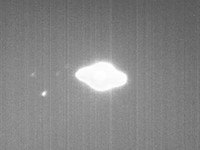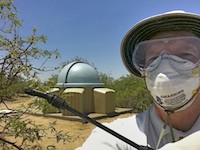4 - 5 June 2011 |
Friday, 3 June, was mostly clear, with wind again (gusts to 25 MPH). Even though I was running on about 4 hours of sleep after my nearly 8 hour session 2-3 June, I had been planning for another long night in the observatory 3-4 June. However, late on Friday afternoon, the wife said we were going on a trip on Saturday. So, I had to slip my plans to Saturday night, 4 June. On Saturday, as sunset approached, there were some high thin clouds and some wind (gust to 21 MPH), but I decided to go out anyway. The observatory was opened at 1911 MST, 92°F. At 1925 MST, viewed the crescent moon at 77X, 133X, and 206X. Nice views. At 1930 MST, a few minutes after sunset, I took the above iPhone 4, afocal, 77X, image with the iPhone mounted on the 8" telescope using the MX-1 afocal adapter. (As with all the images on this page, click the image to see a larger version; click "Index" to return to this page.) This next photo was also taken with the iPhone 4 with a very slight digital zoom shortly after sunset: About an hour after sunset, I took these next iPhone lunar images, afocal, 231X (the 2nd one had a slight digital zoom applied): While I was doing the lunar imaging, I saw the first Kissing Bug of the season: Kissing Bugs are blood suckers and about an inch long. They are not very nice. I had a problem with them a year ago. I sprayed a special mixture near the observatory about a month ago in the hopes of preventing them; perhaps I sprayed too early. I will spray again. I then began testing an iPhone app called "Slow Shutter Cam" (which is different than "Slow Shutter", which I reviewed previously). Here is the moon with Earthshine taken with the iPhone 4 using Slow Shutter Cam (I will post a review soon): Beginning at 2055 MST, I did some lunar observing before the moon lowered into some tree branches. (Kissing Bug count up to 4.) At 2216 MST, I viewed Saturn at 133X. Five moons were visible: Iapetus, Rhea, Titan, Tethys, and Dione. Here is how SkySafari 3 Pro (also being tested) showed the configuration of Rhea, Titan, Tethys, and Dione: This is how the four moons were imaged (reversed in the telescope) with the Slow Shutter app (not Slow Shutter Cam), 30sec, EV+2.0, afocal at 666X: (Kissing Bug count now 6.) At 2156 MST, viewed Saturn at 400X. I hadn't seen any Kissing Bugs for awhile and decided they had gone to bed. But I was premature; at 2202 MST, I saw #7 and then #8, which might have been a queen. At 2213 MST, viewed M13, the Great Globular Cluster in Hercules. I then used Vega to focus the iPhone and went back to M13 and took this image with Slow Shutter, 30sec, EV+2.0, afocal 77X: I ended iPhone imaging at 2250 MST. I took a quick look at M57, the Ring Nebula. (Kissing Bug count now 9.) Next, I set up the D7000 DSLR on a tripod to photograph the Milky Way. This is a 30 second, ISO 1600, f/3.5, 18mm focal length, exposure of the "Milky Way over Cassiopeia Observatory": At 2330 MST, I hadn't seen any Kissing Bugs for a long time. Maybe they finally really went to bed. But number 10 appeared at 0000 MST; guess he got up for a midnight snack. I then began setting up to locate and image Pluto. I switched from the star diagonal to the visual back on the 8" telescope. I used SkySafari 3 Pro to match up stars in the 26mm eyepiece FOV and do some star hopping to the planet. At 0025 MST, I was confident I visually picked it up using averted vision. I attached the D7000 DSLR at prime focus + Off-Axis Guider and waited until it was 48 hours after my previous Pluto image on 3 June. At 0140 MST, I did a guided 5 minute, ISO 1600, exposure. Did I capture Pluto? That would have to wait until I did some image processing. Closed the observatory at 0210 MST, 72°F. During post-processing, I determined that I did indeed image Pluto on 3 June and again on 5 June. Compare the 3 June and 5 June images below (click the 3 June image on the left) and then click the left and right arrows at the top to flip back and forth between the two images). The registration is not perfect since the camera had been removed from the telescope between the two images. But if you study the two images, you will see that Pluto (arrowed) moves between the two dates. Mid-day on Sunday, 5 June, I did the spraying for the Kissing Bugs: Hope it works this time. |














